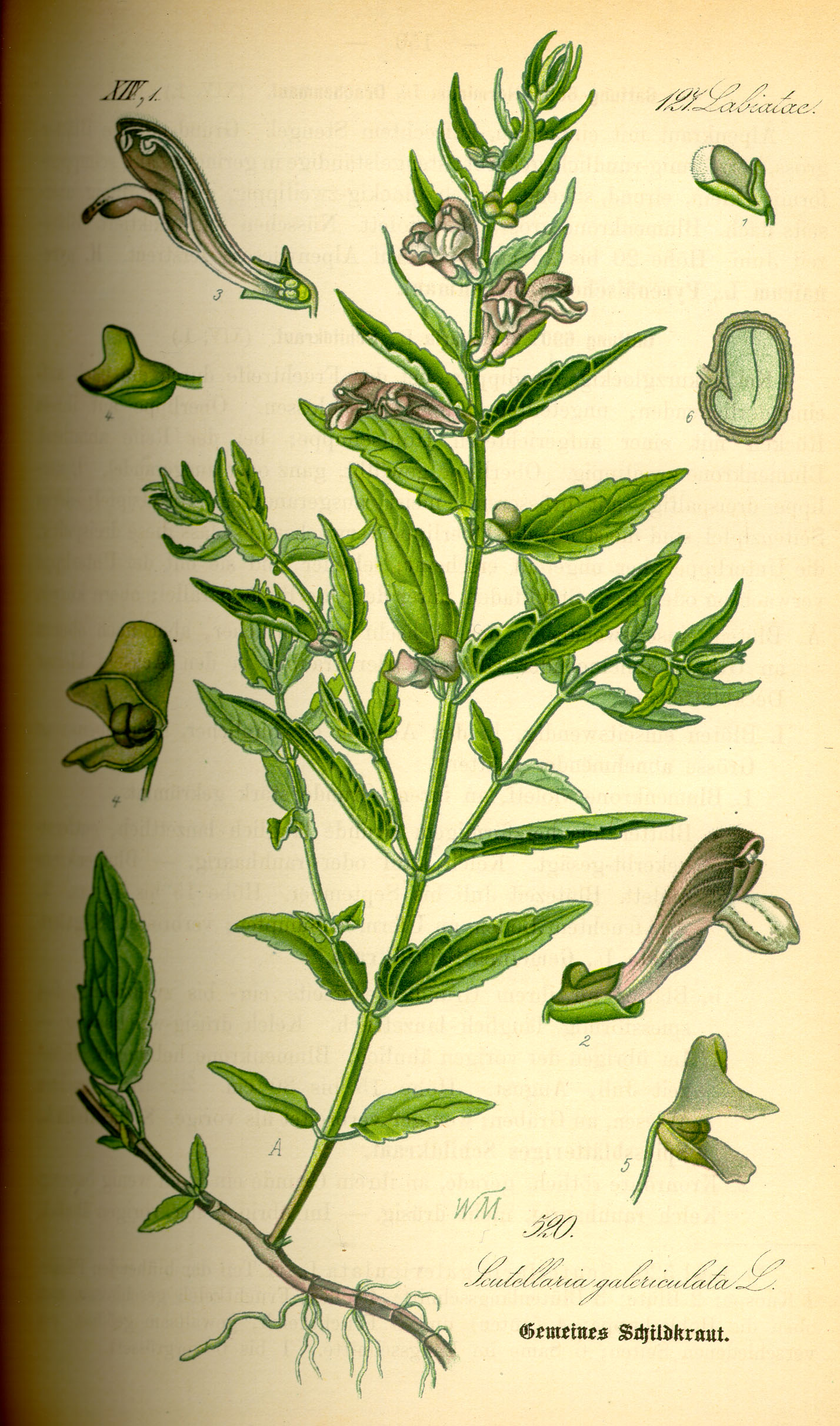- Scutellaria galericulata
Taxobox | name = Common Skullcap

regnum =Plantae
divisio =Magnoliophyta
classis =Magnoliopsida
ordo =Lamiales
familia =Lamiaceae
genus = "Scutellaria "
species = "S. galericulata"
binomial = "Scutellaria galericulata"Common Skullcap ("Scutellaria galericulata var. epilobiifolia"), also known as Marsh Skullcap or Hooded Skullcap, is a hardy perennial
herb native to Britain, Europe, and Asia. It is a member of the mint familyLamiaceae , which also includes many other herbs. The form is upright and is usually 0.2m to 0.45m in height [http://www.plant-identification.co.uk/skye/labiatae/scutellaria-galericulata.htm] [http://www.ibiblio.org/pfaf/cgi-bin/arr_html?Scutellaria+galericulata] . It is a wetland loving species and grows along fens and shorelines. The blue flowers appear in July to September and are 10-20mm long. The flowers are in pairs and are all on the same side of the stem. The flowers do not appear at the top of the stem.The plant is native to many parts of the world and, as such, is known by a variety of names. The Latin "galericulata" means hooded, relating to the length of the flower's tube being much longer than the calyx. [http://www.plant-identification.co.uk/skye/labiatae/scutellaria-galericulata.htm] . The variation "epilobiifolia" translates as "leaves like willow-herb" [http://davesgarden.com/botanary/go/13763/] , and refers to the slightly serrated long thin leaves which look similar to those of the genus
Epilobium .Medicinal uses
"
Scutellaria ", as a genus, has numerous medicinal uses and various species of skullcap are used in the same way. It should be noted though that the traditional uses of Common Skullcap should not be confused with those of other Skullcaps as there are 200 different species of Skullcap and they are not all used in the same way. Blue Skullcap (S. lateriflora) is accepted as the skullcap used in traditionalNorth America n medicine, however Common skullcap shares many of the same active chemicals and is used as a substitute in Britain and Europe.RBH Wills, DL Stuart, "Generation of High Quality Australian Skullcap Products", 2004, ISBN 0642 58730 2, ISSN: 1440-6845 http://www.rirdc.gov.au/reports/EOI/04-020.pdf] . Common skullcap (S. galericulata) is often used in the same way as for Blue Skullcap (S. lateriflora), Western skullcap (S. cordifolia), or Southern skullcap all of which are very genetically similar. [P. Wolfson, MD, and D.L. Hoffmann, FNIMH, ALTERNATIVE THERAPIES, mar/apr 2003, VOL. 9, NO. 2 75.]Blue Skullcap (S. lateriflora) and Common Skullcap are mainly known for their traditional use as a mild sedative (
anxiolytic ) in the form of herbal teas, tablets, capsules, dried leaf for smoking and oral liquid preparations, often in combination with other medicinal herbs. The aqueous extract of the flowering parts have been traditionally used by Native Americans as a nerve tonic and for itssedative anddiuretic properties. [Millspaugh, C. F. American Medicinal Plants; Dover Publications: New York, 1974; pp 469-472]Blue Skullcap (S. lateriflora) is also known to prevent the recurrence of seizure. ["Herbal treatment following post-seizure induction in rat by lithium pilocarpine: Scutellaria lateriflora ( Skullcap ), Gelsemium sempervirens (Gelsemium) and Datura stramonium (Jimson Weed) may prevent development of spontaneous seizures."Phytother Res. 2004 Sep;18(9):700-5. ]
Pharmacology
Main chemical constituents Chemical Part Concentration (mg/g) BAICALIN Leaf 10P.H. and Horhammer, L., Hager's Handbuch der Pharmazeutischen Praxis, Vols. 2-6, Springer-Verlag, Berlin, 1969-1979.] CHRYSIN-7-GLUCURONIDE Plant 27 TANNIN Plant 28-35 [Lawrence, B.M., Essential Oils 1976-1977, Essential Oils 1978, Essential Oils 1979-1980.] The principle phenolics in the leaves, stems, and roots are baicalein and wogonin. [Nishikawa, et al. Phenolics in tissue cultures of Scutellaria. Natural Medicines 53: 209-213,1999] . Another study identifies 5,6,7-trihydroxy-2'- methoxyflavone and its 7-0-glucuronide. [Analysis of Scutellaria lateriflora and its adulterant Teucrium canadense by HPLC-UV and HPLC-UV/MS, Tom's of Maine, PO Box 710, Kennebunk, ME 04043,USA] . A number of the flavones found in S. lateriflora have been reported to selectively bind with high affinity to central
benzodiazepine receptor sites, leading to the view that the flavones exertsanxiolytic and otherbenzodiazepine effects in rats. [Medina, et al. , Overview-Flavonoids: A new family ofbenzodiazapine receptor ligands. Neurochem Res. 199722 (4): 419.]Common skullcap contains the flavonoid glycosides
baicalin , dihydrobaicalin andchrysin glucuronide. Baicalin is known to beanti-inflammatory andanalgesic [Anesth Analg 2003;97:1724-1729 [http://www.anesthesia-analgesia.org/cgi/content/full/97/6/1724|http] ] . Chrysin is found naturally in various plants including the Pelargonium species, which are germanium-like plants; the Passiflora or passion flower species, which include tropical passion fruit; and the Pinaceae species, including pine trees.Chrysin is sold as a nutritional supplement for male body builders because of its possible action in inhibiting the conversions ofandrogens toestrogens [Kellis JT Jr, Vickery LE. Inhibition of human estrogen synthetase (aromatase) by flavones. Science. 1984; 225:1032-1034.] .The
flavonoids are found throughout the plant but are more concentrated in the leaves, and the concentrations are found to decrease slightly as the plant matures. The dried leaf is reported to contain ~50 mg/g offlavonoids . Theflavonoids are readily extracted using hot water."Comparison of the Chemical Composition of Extracts from Scutellaria lateriflora Using Accelerated Solvent Extraction and Supercritical Fluid Extraction versus Standard Hot Water or 70% Ethanol Extraction." J. Agric. Food Chem., 53 (8), 3076 -3080, 2005]Several neo-clerodane diterpenoids with insect anti-feedant activity have been reported from S. galericulata. [M.D. Cole, J.C. Anderson, W.M. Blaney, L.E. Fellows, S.V. Ley, R.N. Sheppard and M.S.J. Simmonds,Phytochemistry, 29, 1793-1796 (1990).] [B. Rodriguez, M.C. de la Torre, B. Rodriguez, M. Bruno, F. Piozzi, G. Savona, M.S.J. Simmonds, W.M. Blaney and A. Perales, Phytochemistry, 33, 309-315 (1993).] [B. Rodriguez, M.C. de la Torre, B. Rodriguez and P. Gomez-Serranillos, Phytochemistry, 41, 247-253 (1996).]
References
ee also
*
Anxiolytic
*Sedative
*Valerian
*Anxiety
*Herbalism
*Special Herbs, Vols. 4, 5 & 6
*Special Herbs, Vols. 5 & 6 External links
* [http://sun.ars-grin.gov:8080/npgspub/xsql/duke/plantdisp.xsql?taxon=918 Dr. Duke'sPhytochemical and Ethnobotanical Databases]
* [http://www.raysahelian.com/skullcap.html Skullcap herb info]
Wikimedia Foundation. 2010.
